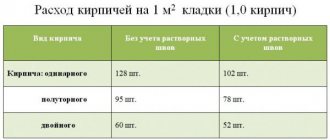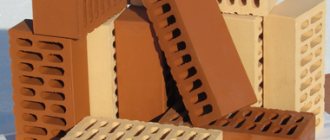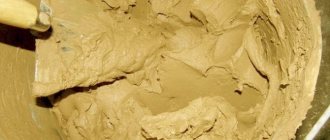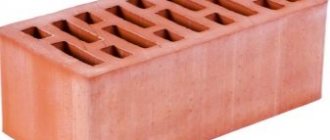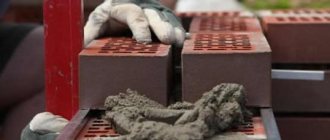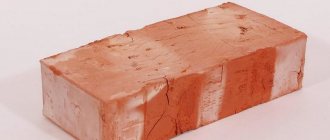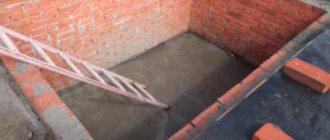Planning is one of the important points that is emphasized during construction. It is very important to calculate the rate of brick consumption in advance, since during the work you may encounter a shortage of building materials. This raises the question - how many bricks are there in 1m2 of masonry, which we will try to answer.
The consumption of bricks for the construction of walls may vary, so it is important to take into account the type of material, the thickness of the walls of the future building and other important requirements
How to calculate the wall area?
To calculate how much brick is consumed per 1 m2, proceed according to the following calculation algorithm:
- Measure the length and width of the wall and find their product, that is, multiply the results together. These calculations must be made for any wall - be it a square or rectangular surface.
- Summarize all indicators obtained as a result of measurements.
- Next, the length and width of the window opening are measured, the indicators of which are also multiplied. If there are several windows, the product of the length and width for each is also summed up.
- The area of the doorway is calculated in the same way - multiply the length by the width.
- From the indicator of the sum of the areas of the walls, the sum of the areas of windows and doors is subtracted. This result will be the area of the wall.
In the example it will look like this. There is a wall with length and width indicators, as well as window and door openings.
A clear example of how to calculate square meters of a wall
- Wall area including openings = 3000 mm * 5000 mm = 15,000,000 mm = 15 m2
- Doorway area = 900 mm * 2200 mm = 198,000 mm = 1.98 m2
- Window opening area = 300 * 400 = 120,000 mm = 1.2 m2
- Wall covering area = 15 m2 – 1.98 m2 – 1.2 m2 = 11.83 m2
If you make calculations for several surfaces at the same time, then the final results of the wall coverage area are summed up.
When all the calculations are completed, you can calculate the volume of material in the masonry that will be needed for specific work.
It is necessary to calculate the area of the walls
To accurately calculate the number of elements, you should calculate the total area of the façade base. To perform the calculation, follow the steps in order:
- Take measurements of the length and height of the base. Multiply the received data. A calculation must be performed for each rectangular surface.
- Add up the results.
- Take measurements of all openings, including door panels and window frames. Multiply the length by the width and add the results together.
- From the overall result indicator, minus the sum of the opening areas.
After the calculations were made, the area that needs to be covered with bricks was obtained. Next, you should start counting the number of façade elements.
It is worth considering that additional material is needed for edging corners, as well as framing openings, while the size of the seams is not taken into account. During the work process, building materials may split and this should also be taken into account when purchasing.
Types and sizes of bricks when calculating
An important point when calculating how many bricks are needed in 1 m3 of masonry are the dimensional characteristics of the material itself. Manufacturers are known to sell several types:
It is also necessary to remember that there are standardized dimensions for the thickness of joints between masonry:
- vertically – 10 mm;
- horizontally – 12 mm.
Using a single brick is the best option, as it is most convenient for laying rows both horizontally and vertically. If you need to reduce the work time, then it is advisable to use one-and-a-half bricks. As for double brick, its use is not recommended when constructing the foundation and lower parts of the building, since it has low strength.
It should be noted that these dimensions refer only to the material that is manufactured in accordance with GOST standards. If the production took place according to other technical requirements and it has different dimensions, then to determine the required amount of brick in a cube, measure its parameters yourself.
Brick calculation: what needs to be taken into account?
To find out how many bricks are needed in 1m2 of masonry, you need to determine the required wall thickness, which depends on the specific type of masonry material. So, there are standard parameters:
For continental and temperate continental climates, experts recommend a thickness of two or two and a half brick blocks. In addition, the calculation of the amount of brick must be carried out taking into account other features:
- building height;
- originality of the walls;
- type of floors in case of several floors;
- type of masonry;
- the presence of seams or their absence.
Calculation of wall area
The basis for all construction calculations is the following indicator: in 1 cubic. meter – 480 pcs. red standard brick size 250*120*65. This indicator is convenient when calculating the required quantity, and when purchasing from a warehouse and during transportation.
To find out the brick consumption per 1 m2 of masonry, you need to know the thickness of the walls, which depends on the laying of the material:
- half a brick – 120 mm;
- in one brick - 250 mm;
- one and a half bricks - 380 mm;
- in two bricks - 510 mm;
- two and a half bricks - 640 mm.
For the Russian climate, the best option is to lay walls with two and two and a half bricks. Several other parameters should be taken into account: the number of storeys (height) of the building, the type of floors, and the individual characteristics of the building. After specifying the thickness, you need to determine the length of the building along the perimeter and its height. The product of these quantities will result in the perimeter area of the house. But at the same time, you should remember about door and window openings, the area of which should preferably be subtracted from the total area of the walls. The result is the total area of the structure being built, from which the amount of material required for its construction is determined.
We recommend these articles:
What is the volumetric weight of brickwork?
What are the dimensions of a Lego brick?
Types of masonry, with or without seams
There are certain standards for the number of bricks in 1m2 of masonry. Of course, these results are indicative. In any case, during the work unforeseen circumstances arise, which also need to be taken into account. For example, this could be a breakdown of the material, an increase in the seam layer in some areas, an initially incorrect calculation of how many pieces are in a cube, and an incorrect wall area.
Seam dimensions in brickwork according to SNiP
Types of masonry
The answer to the question of how many facing bricks are in 1m2 of masonry depends on the type of masonry chosen. There are many types of masonry, the most popular of which are:
- Spoon. The bricks are laid with a spoon facing outward and each subsequent row is shifted relative to the previous one by 1⁄2 or 1⁄4 bricks.
- Tychkovaya. Laying is done by poking outwards. Each subsequent row is offset from the previous one by 1⁄2 bricks.
All other types of facing brick masonry, including cross, Flemish, Selesian, Dutch, chain and Gothic masonry, are alternating bricks laid with the tongue and butt sides, in different combinations.
Amount of solution per 1 m²
The reliability of masonry depends on the quality of the cement mortar, its proper preparation and added impurities. Also, the consumption of the consumed mixture per square meter is influenced by the level of moisture absorption of the material, the porosity of its surface and the time of year when the work is carried out.
If the bar has a porous surface, treatment with the solution increases by approximately 20% of the previously calculated amount of material per 1 m2.
Taking into account the brand of cement, you can find out that for a wall of ¼ brick you will need material per 1 m2 of masonry:
- M100 – 5 kg;
- M75 – 4 kg;
- M50 – 2.5 kg.
It is important to prepare the required amount of solution in compliance with technological recommendations.
In addition, you can calculate the amount of solution for ceramic and silicate materials, taking into account standard standards:
- cladding thickness of 25 cm - 0.62 m2 (for ceramics and silicate);
- wall depth of 38 cm - 0.095 m2 (for empty);
- width 25 cm - 0.05 m2 (for empty).
If you have made all the calculations correctly and correctly prepared the cement mortar, then its consumption will correspond to the following standards indicated in the table:
The number of facing bricks in a pallet depending on the type
As a rule, during shipment the material is placed in special pallets. This is necessary not only for its safety during transportation, but also for control of shipment and convenience during operation.
Pallets are made of wood and come in two types:
- small – 520*1030 mm;
- large – 770*1030 mm.
Often, a responsible manufacturer will indicate the quantity per pallet. If the label is missing for some reason, then you can calculate how many bricks are in the first row based on the following formula: the area of the pallet is divided by the area of the brick block. This indicator is multiplied by the total number of rows.
In the construction industry, of course, there are rules and regulations. So, on a 770 mm pallet a certain number of brick blocks are stacked, depending on its type:
If you have calculated the area in advance, then determining the number of pallets needed for brickwork is very easy to calculate.
Scheme of laying bricks on a pallet
How many bricks are in the masonry: table
During the work, the most unpleasant moment is considered to be a lack of material and additional financial expenses associated with transportation after additional purchase. Of course, the ideal option is to purchase and deliver the necessary bricks at one time.
Many construction sites have come to the rescue and have developed an online calculation calculator that helps calculate the exact amount of material for masonry. So, it allows you not only to determine the number of bricks in 1 m2 of masonry, but also to calculate the total number of pieces for the entire wall area. The calculator also calculates bricks for masonry, taking into account its size, the type of masonry itself, and also taking into account seams or without them. All you have to do is enter the appropriate data and in two to three seconds you will receive the calculation result. In any case, to determine the amount of building material required, you can use the data given in the table:
Calculating the amount of brick required per 1 m2 is actually not a difficult task. You only need to know the thickness of the masonry, the dimensions of the brick block, and the area of the walls being erected. Next, you can use either a calculation calculator or look at the value in the table. But even in this case, it must be remembered that any building material, especially in large quantities, contains defects. As for brick blocks, defects account for about 4-6% of the total quantity, so the purchase should certainly be made with a reserve.
How many bricks are in 1 m2
How many bricks are there in a square meter?
Construction always begins with the acquisition of the necessary materials. To build a brick house, the first step is to determine the consumption of building stone. This is done in order to buy material from one batch. In the case of an additional purchase, there is no guarantee that it will completely match the color of the brick purchased in advance. Such an omission can negatively affect the appearance of the building. To find out the required volume of material, you need to know the number of bricks per square meter.
Calculation of wall area
The basis for all construction calculations is the following indicator: in 1 cubic. meter – 480 pcs. red standard brick size 250*120*65. This indicator is convenient when calculating the required quantity, and when purchasing from a warehouse and during transportation.
To find out the brick consumption per 1 m2 of masonry, you need to know the thickness of the walls, which depends on the laying of the material:
- half a brick – 120 mm;
- in one brick - 250 mm;
- one and a half bricks - 380 mm;
- in two bricks - 510 mm;
- two and a half bricks - 640 mm.
For the Russian climate, the best option is to lay walls with two and two and a half bricks. Several other parameters should be taken into account: the number of storeys (height) of the building, the type of floors, and the individual characteristics of the building. After specifying the thickness, you need to determine the length of the building along the perimeter and its height. The product of these quantities will result in the perimeter area of the house. But at the same time, you should remember about door and window openings, the area of which should preferably be subtracted from the total area of the walls. The result is the total area of the structure being built, from which the amount of material required for its construction is determined.
We recommend these articles:
Brick dimensions when calculating
An important value in the calculation is the dimensions of the brick itself. Factories produce several types of bricks: single, one-and-a-half and double bricks.
- dimensions of one-and-a-half bricks – 250*120*88 mm;
- double brick dimensions – 250*120*138 mm;
- dimensions of a single brick – 250*120*65 mm.
It is necessary to remember the thickness of the seams between the rows:
- vertical seam – 10 mm;
- horizontal – 12 mm.
Popular publications:
Brick consumption for certain masonry schemes
There is special data on how many bricks are in 1m2 of masonry in 0.5 bricks:
- single brick – 61 pcs. excluding seam, 51 pcs. with seam;
- one-and-a-half brick – 46 pcs. excluding seam, 39 pcs. with seam;
- double brick – 30 pcs. excluding seam, 26 pcs. with a seam.
You can also find out how many bricks are in 1 m2 of masonry in 1 brick:
- single brick – 128 pcs. without seam, 102 pcs. with seam;
- one-and-a-half brick – 95 pcs. without seam, 78 pcs. with seam;
- double brick – 60 pcs. without seam, 52 pcs. with a seam.
The amount of brick in 1m2 of masonry in 1.5 bricks is also standardized:
- single brick – 189 pcs. excluding seam, 153 pcs. with seam;
- one-and-a-half brick – 140 pcs. excluding seam, 117 pcs. with seam;
- double brick – 90 pcs. excluding seam, 78 pcs. with a seam.
In special tables you can see how many pieces of bricks are needed in 1m2 of masonry with 2 bricks:
- single brick – 256 pcs. without solution, 204 pcs. with solution;
- one-and-a-half brick - 190 pcs., and, accordingly, 156 pcs.;
- double brick – 120 pcs., and 104 pcs.
When laying a wall with two and a half stones, it should be taken into account that in 1 sq. meter:
- single brick – 317 and 255 pieces;
- one-and-a-half brick - 235 and 195 pieces;
- double brick - 150 and 130 pieces.
It is not difficult to calculate the consumption of facing bricks per 1 m2. When used in calculations of seam parameters, it will look like this:
- red regular brick – 54 pcs.;
- standard facing – 85 pcs.;
- large facing brick - about 14 pcs.
You will notice that the calculations are simple and easy, you just need to know the parameters of the structure and the dimensions of the brick.
Next, you should select the desired value from the list or table and multiply it by the pre-calculated wall area. This is how the required amount of bricks is found for the construction of the building. It should be borne in mind that the volume of defective bricks is usually 5-7% of the total volume of goods. Therefore, it is best to purchase building materials with a reserve.
